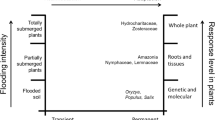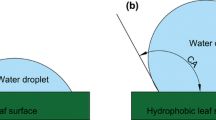Abstract
The duration and amount of water captured on leaves and its functional significance is highly varied. Leaf surface wettability influences water absorption, gas exchange, pathogen infection, nutrient leaching, contamination by pollutants, self-cleaning properties and in freezing environments the probability of extrinsic ice nucleation. To test the impact of environment on the development of leaf wettability, this functional trait was measured in 227 dominant plant species along an extreme altitudinal environment gradient (186–5,268 m) on the wet and dry slopes of the Nepalese Himalayas. Plants from the understorey and open places in woodlands were also compared. Leaf wettability was assessed by droplet contact angle (θ), retention and leaf inclination measurement. With increasing altitude leaf wettability decreased significantly parallel to the observed atmospheric temperature decrease (0.5 K/100 m). Leaves from non-freezing tropical and subtropical origins were highly wettable (θ < 90°). Temperate leaves were non-wettable (110° < θ < 130°). Subalpine and alpine leaves were highly non-wettable (130° < θ < 150°) and adaxial pubescence occurred more frequently. Leaves taken from the understorey were more wettable but had a better droplet run off than leaves sampled in open places. In the semi-arid northern slopes (temperate to alpine) of the Himalayas leaf wettability was decreased in comparison to the southern humid side. The majority of the leaves had a low droplet retention <20°; higher values were linked to high non-wettability (θ > 130°) which was more often observed at high altitude. Good droplet run off at ±10° inclination was found in highly wettable leaves (θ < 90°) of tropical and subtropical origin and on leaves from the forest understorey. Structural properties for low wettability are developed in cold and dry environments and open sites with frequent dew formation as it appears to be an important functional trait to prevent a number of the negative effects adhering surface water may have.










Similar content being viewed by others
References
Anfodillo T, Bisceglie D, Urso T (2002) Minimum cuticular conductance and cuticle features of Picea abies and Pinus cembra needles along an altitudinal gradient in the Dolomites (NE Italian Alps). Tree Physiol. doi:10.1093/treephys/22.7.479
Barry RG (1992) Mountain weather and climate, 2nd edn. Routledge, London
Barthlott W, Neinhuis C (1997) Purity of sacred lotus, or escape from contamination in biological surfaces. Planta 202:1–8
Billings WD, Mooney HA (1968) The ecology of arctic and alpine plants. Biol Rev 43:481–530
Bradley DJ, Gilbert GS, Parker IM (2003) Susceptibility of clover species to fungal infection: the interaction of leaf surface traits and environment. Am J Bot 90(6):857–864
Brewer CA, Nuñez CI (2007) Patterns of leaf wettability along an extreme moisture gradient in western Patagonia, Argentina. Int J Plant Sci. doi:10.1086/513468
Brewer CA, Smith WK (1994) Influence of simulated dewfall on photosynthesis and yield in soybean isoline (Glycine max [L.] Merr. cv. Williams) with different trichome densities. Int J Plant Sci. doi: 10.1086/297183
Brewer CA, Smith WK (1995) Leaf surface wetness and gas exchange in the pond lily Nuphar polysepalum (Nymphaceae). Am J Bot 82(10):1271–1277
Brewer CA, Smith K (1997) Patterns of leaf surface wetness for montane and subalpine plants. Plant Cell Environ. doi: 10.1046/j.1365-3040.1997.d01-15.x
Brewer CA, Smith WK, Vogelmann TC (1991) Functional interaction between leaf trichomes, leaf wettability and the optical properties of water droplets. Plant Cell Environ. doi: 10.1111/j.1365-3040.1991.tb00965.x
Burgess SSO, Dawson TE (2004) The contribution of fog to the water relations of Sequioa sempervirens (D. Don): foliar uptake and prevention of dehydration. Plant Cell Environ. doi: 10.1111/j.1365-3040.2004.01207.x
Cape JN (1996) Surface wetness and pollutant deposition. In: Kerstiens G (ed) Plant cuticles: an integrated approach. Bios Scientific, Oxford, pp 283–300
Chaudhary RP (1998) Biodiversity in Nepal. Know Nepal series, vol 17. Craftsman Press, Bangkok
Chen THH, Burke MJ, Gusta LV (1995) Freezing tolerance in plants: an overview. In: Lee RE, Warren GJ, Gusta LV (eds) Biological ice nucleation and its applications. APS, St Paul, pp 115–136
Crisp DJ (1963) Waterproofing in animals and plants. In: Moilliet JL (ed) Waterproofing and water-repellency. Elsevier, Amsterdam, pp 416–481
Dobremez JF (1976) Le Népal, Écologie et biogégraphie. Centre National de la Rechereche Scientifique, Paris
Dobremez JF, Shakya PR (1975) Carte Ecologique du Népal. VI. Region Biratnagar–Kanchenjunga 1:250, 000. Cahiers Nepalais documents, 7th edn. CNRS, Paris
Evans KJ, Nyquist WE, Latin RX (1992) A model based on temperature and leaf wetness duration for establishment of Alternaria leaf blight of muskmelon. Phytopathology. doi: 10.1094/Phyto-82-890
Fogg GE (1948) Adhesion of water to the external surfaces of leaves. Faraday Discuss Chem Soc 3:162–166
Hacker J, Neuner G (2007) Ice propagation in plants visualized at the tissue level by IDTA (infrared differential thermal analysis). Tree Physiol. doi: 10.1093/treephys/27.12.1661
Hacker J, Neuner G (2008) Ice propagation in dehardened alpine plant species studied by infrared differential thermal analysis (IDTA). Arct Alp Res. doi: 10.1657/1523-0430(07-077)[HACKER]2.0.CO;2
Hanba YT, Moriya A, Kimura K (2004) Effect of leaf surface wetness and wettability on photosynthesis in bean and pea. Plant Cell Environ. doi: 10.1046/j.1365-3040.2004.01154.x
Holder CD (2007a) Leaf water repellency of species in Guatemala and Colorado (USA) and its significance to forest hydrology studies. J Hydrol. doi: 10.1016/j.jhydrol.2006.12.018
Holder CD (2007b) Leaf water repellency as an adaptation to tropical montane cloud forest environments. Biotropica. doi: 10.1111/j.1744-7429.2007.00303.x
Ishibashi M, Terashima I (1995) Effect of continuous leaf wetness on photosynthesis: adverse aspect of rainfall. Plant Cell Environ. doi: 10.1111/j.1365-3040.1995.tb00377.x
Jones HG (1992) Plants and microclimate, 2nd edn. Cambridge University Press, Cambridge
Jordan DN, Smith WK (1994) Energy balance analysis of nighttime leaf temperatures and frost formation in a subalpine environment. Agric For Meteorol. doi: 10.1016/0168-1923(94)90020-5
Körner C (2003) Alpine plant life, 2nd edn. Springer, Berlin
Körner C, Larcher W (1988) Plant life in cold climates. In: Long SP, Woodward FI (eds) Plants and temperature. Soc Exp Biol, Cambridge, pp 25–57
Lange OL, Beyschlag W, Tenhunen JD (1987) Control of leaf carbon assimilation—input of chemical energy into ecosystems. In: Schulze ED, Zwölfer H (eds) Potentials and limitations of ecosystem analysis. Springer, Berlin, pp 149–163
Larcher W (2003) Physiological plant ecology, 4nd edn. Springer, Berlin
Massman WJ, Pederson J, Delany A, Grantz D, Hartog GD, Neumann HH, Oncley SP, Pearson J, Shaw RH (1994) An elevation of the regional acid deposition model surface module for ozone uptake at three sites in the San Joaquin Valley of California. J Geophys Res 99:8281–8294
Neinhuis C, Barthlott W (1997) Characterization and distribution of water repellent, self cleaning plant surfaces. Ann Bot. doi: 10.1006/anbo.1997.0400
Nobel PS (1991) Physicochemical and environmental plant physiology. Academic Press, San Diego
Pandey S, Nagar PK (2002) Leaf surface wetness and morphological characteristics of Valeriana jatamansi grown under open and shade habitats. Biol Plant. doi:10.1023/A:1015165210967
Pandey S, Nagar PK (2003) Pattern of leaf surface wetness in some important medicinal and aromatic plants of western Himalaya. Flora 198:349–357
Pearce RS, Fuller MP (2001) Freezing of barley studied by infrared video thermography. Plant Physiol 125:227–240
Reynolds KM, Madden LV, Richard DL, Ellis MA (1989) Splash dispersal of Phytophthora cactorum from infected strawberry fruit by simulated canopy drip. Phytopathology. doi: 10.1094/Phyto-79-425
Rundel PW, Lange OL (1980) Water relations and photosynthetic response of a desert moss. Flora 169:329–335
Schmitt AK, Martin CE, Lüttge UE (1989) Gas exchange and water vapour uptake in the atmospheric CAM bromeliad Tillandsia recurvata L., the influence of trichomes. Bot Acta 102:80–84
Smith WK, McClean TM (1989) Adaptive relationship between leaf water repellency, stomatal distribution, and gas exchange. Am J Bot 76(3):465–469
Taschler D, Neuner G (2004) Summer frost resistance and freezing patterns measured in situ in leaves of major alpine plant growth forms in relation to their upper distribution boundary. Plant Cell Environ. doi: 10.1111/j.1365-3040.2004.01176.x
Terashima I, Masuzawa T, Obha H (1993) Photosynthetic characteristics of a giant alpine plant, Rheum nobile Hook. f. et Thoms. and of some other alpine species measured at 4300 m, in the eastern Himalaya, Nepal. Oecologia. doi: 10.1007/BF00323490
Thomas DA, Barber HN (1974) Studies on leaf characteristics of a cline of Eucalyptus urnigera from Mountain Wellington, Tasmania. l. Water repellency and the freezing of leaves. Aust J Bot. doi: 10.1071/BT9740501
Tsukaya H, Tsuge T (2001) Morphological adaptation of inflorescence in plants that develop at low temperature in early spring: the convergent evolution of “Downy Plants”. Plant Biol 3:536–543
Wisniewski M, Fuller MP (1999) Ice nucleation and deep supercooling in plants: new insights using infrared thermography. In: Margesin R, Schinner F (eds) Cold adapted organisms. Ecology physiology, enzymology and molecular biology. Springer, Berlin, pp 105–118
Wisniewski M, Fuller MP, Glenn DM, Gusta L, Duman J, Griffith M (2002a) Extrinsic ice nucleation in plants: what are the factors involved and can they be manipulated? In: Li PH, Palva ET (eds) Plant cold hardiness: gene regulation and genetic engineering. Kulwer, New York, pp 211–222
Wisniewski M, Glenn DM, Fuller MP (2002b) Use of a hydrophobic particle film as a barrier to extrinsic ice nucleation in tomato plants. J Am Soc Hortic Sci 127(3):358–364
Yates DJ, Hutley LB (1995) Foliar uptake of water by leaves of Slonea wollsii, an Australian subtropical rainforest tree. Aust J Bot. doi:10.1071/BT9950157
Yoshimitsu Z, Nakajima A, Watanable T, Hashimoto K (2002) Effects of surface structure on the hydrophobicity and sliding behavior of water droplets. Langmuir. doi:10.1021/la020088p
Acknowledgments
This study was funded by the Austrian Science Fund FWF-project P17188-B03 and by the OeAD via a Ph.D. scholarship to Biva Aryal (41/2 EZA/2005). We sincerely thank Jürgen Hacker for his help preparing the figures and Thirta Panta for excellent field guiding in the Himalayas.
Author information
Authors and Affiliations
Corresponding author
Additional information
Communicated by Marilyn Ball.
Electronic supplementary material
Below is the link to the electronic supplementary material.
Rights and permissions
About this article
Cite this article
Aryal, B., Neuner, G. Leaf wettability decreases along an extreme altitudinal gradient. Oecologia 162, 1–9 (2010). https://doi.org/10.1007/s00442-009-1437-3
Received:
Accepted:
Published:
Issue Date:
DOI: https://doi.org/10.1007/s00442-009-1437-3




